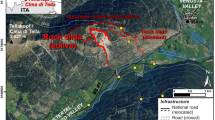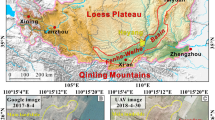Abstract
The mechanisms of high-speed and long-runout landslides are reflected in the geomorphology of their deposits. Comprehensive field investigation using unmanned aerial vehicles photography was undertaken to observe special landforms of the Dora Kamiyama rockslide in the Tibetan Plateau. The dynamic processes of the rockslide were analysed based on the complex topography that remained. The age of sediments sampled from the landslide lake was tested through optically stimulated luminescence (OSL). In translation zone II, the landslide material near both edges underwent sinistral or dextral shearing motions, forming levees. In accumulation subzones III-1 and III-2, a rapid extensional sliding process contributed to toreva block formation. Transverse and longitudinal ridges developed due to compression-dominated processes in subzone III-2. Meanwhile, high-speed material was overturned in subzone III-3 due to the original topographical resistance, and carapace facies featuring abundant megablocks were clearly visible on the surface. Ridges confined by troughs were well-developed across the area experiencing rapid radial spreading motion in subzone III-4. Finally, dynamic parameters of the rockslide were calculated. The equivalent friction coefficient and the angle of reach were 0.40 and 21.80°, respectively. The maximum sliding velocity was estimated between 37.42 and 54.73 m/s. The OSL ages showed that the occurrence time of the rockslide can be estimated to be 4.24 ± 0.35 ka, defining it as an ancient landslide in the Holocene.














Similar content being viewed by others
References
Andrade SD, van Wyk de Vries B (2010) Structural analysis of the early stages of catastrophic stratovolcano flank-collapse using analogue models. Bull Volcanol 72:771–789. https://doi.org/10.1007/s00445-010-0363-x
Barth NC (2014) The Cascade rock avalanche: implications of a very large Alpine Fault-triggered failure, New Zealand. Landslides 11:327–341. https://doi.org/10.1007/s10346-013-0389-1
Chen T (2014) Study on the exploration and genesis of hot spring in Chamdo region Ba Su County Bai Ma Town. Chengdu University of Technology
Clavero JE, Sparks RSJ, Huppert HE (2002) Geological constraints on the emplacement mechanism of the Parinacota debris avalanche, northern Chile. Bull Volcanol 64:40–54. https://doi.org/10.1007/s00445-001-0183-0
Dai ZL, Wang FW, Cheng QG, Wang YF, Yang HF, Lin QW et al (2019) A giant historical landslide on the eastern margin of the Tibetan Plateau. Bull Eng Geol Environ 78:2055–2068. https://doi.org/10.1007/s10064-017-1226-x
Davies TR, McSaveney MJ, Hodgson KA (1999) A fragmentation-spreading model for long-runout rock avalanches. Can Geotech J 36:1096–1110. https://doi.org/10.1139/cgj-36-6-1096
Davies TR, McSaveney MJ (2009) The role of rock fragmentation in the motion of large landslides. Eng Geol 109:67–79. https://doi.org/10.1016/j.enggeo.2008.11.004
Dufresne A, Davies TR (2009) Longitudinal ridges in mass movement deposits. Geomorphology 105:171–181. https://doi.org/10.1016/j.geomorph.2008.09.009
Dufresne A, Bosmeier A, Prager C (2016a) Sedimentology of rock avalanche deposits - case study and review. Earth Sci Rev 163:234–259. https://doi.org/10.1016/j.earscirev.2016.10.002
Dufresne A, Prager C, Bosmeier A (2016b) Insights into rock avalanche emplacement processes from detailed morpho-lithological studies of the Tschirgant deposit (Tyrol, Austria). Earth Surf Process Landf 41:587–602. https://doi.org/10.1002/esp.3847
Dufresne A, Geertsema M (2020) Rock slide–debris avalanches: flow transformation and hummock formation, examples from British Columbia. Landslides 17:15–32. https://doi.org/10.1007/s10346-019-01280-x
Dufresne A, Geertsema M, Shugar DH, Koppes M, Higman B, Haeussler PJ et al (2018) Sedimentology and geomorphology of a large tsunamigenic landslide, Taan Fiord, Alaska. Sediment Geol 364:302–318. https://doi.org/10.1016/j.sedgeo.2017.10.004
Evans SG, Hungr O, Clague JJ (2001) Dynamics of the 1984 rock avalanche and associated distal debris flow on Mount Cayley, British Columbia, Canada; implications for landslide hazard assessment on dissected volcanoes. Eng Geol 61:29–51. https://doi.org/10.1016/s0013-7952(00)00118-6
Evans SG, Roberts NJ, Ischuk A, Delaney KB, Morozova GS, Tutubalina O (2009) Landslides triggered by the 1949 Khait earthquake, Tajikistan, and associated loss of life. Eng Geol 109:195–212. https://doi.org/10.1016/j.enggeo.2009.08.007
Fang H, Cui P (2010) Study on mechanical mechanism and controlling factors of highspeed distant landslides induced by the Wenchuan Earthquake. Journal of Catastrophology 25(s):120–126 (In Chinese)
Friedmann SJ, Kwon G, Losert W (2003) Granular memory and its effect on the triggering and distribution of rock avalanche events. Journal of Geophysical Research-Solid Earth 108:12. https://doi.org/10.1029/2002jb002174
Ge Y, Tang H, Eldin MAME, Chen H, Zhong P, Zhang L, Fang K (2018) Deposit characteristics of the jiweishan rapid long-runout landslide based on field investigation and numerical modeling. Bull Eng Geol Environ 78(6):4383–4396. https://doi.org/10.1007/s10064-018-1422-3
Guo CB, Montgomery DR, Zhang YS, Wang K, Yang ZH (2015) Quantitative assessment of landslide susceptibility along the Xianshuihe fault zone, Tibetan Plateau, China. Geomorphology 248:93–110. https://doi.org/10.1016/j.geomorph.2015.07.012
Guzzetti F, Ardizzone F, Cardinali M, Rossi M, Valigi D (2009) Landslide volumes and landslide mobilization rates in Umbria, central Italy. Earth Planet Sci Lett 279:222–229. https://doi.org/10.1016/j.epsl.2009.01.005
Hungr O, Leroueil S, Picarelli L (2014) The Varnes classification of landslide types, an update. Landslides 11:167–194. https://doi.org/10.1007/s10346-013-0436-y
Iverson RM, George DL, Logan M (2016) Debris flow runup on vertical barriers and adverse slopes. Journal of Geophysical Research-Earth Surface 121:2333–2357. https://doi.org/10.1002/2016jf003933
Johnson CG, Kokelaar BP, Iverson RM, Logan M, LaHusen RG (2012) Grain-size segregation and levee formation in geophysical mass flows. Journal of Geophysical Research: Earth Surface 117(F1). https://doi.org/10.1029/2011JF002185
Jibson RW, Harp EL, Schulz W, Keefer DK (2006) Large rock avalanches triggered by the M 7.9 Denali Fault, Alaska, earthquake of 3 November 2002. Eng Geol 83:144–160. https://doi.org/10.1016/j.enggeo.2005.06.029
Legros F (2002) The mobility of long-runout landslides. Eng Geol 63:301–331. https://doi.org/10.1016/s0013-7952(01)00090-4
Liu W, He SM, Li XP, Xu Q (2016) Two-dimensional landslide dynamic simulation based on a velocity-weakening friction law. Landslides 13:957–965. https://doi.org/10.1007/s10346-015-0632-z
Longchamp C, Abellan A, Jaboyedoff M, Manzella I (2016) 3-D models and structural analysis of rock avalanches: the study of the deformation process to better understand the propagation mechanism. Earth Surface Dynamics 4:743–755. https://doi.org/10.5194/esurf-4-743-2016
Lucas A, Mangeney A, Ampuero JP (2014) Frictional velocity-weakening in landslides on Earth and on other planetary bodies. Nat Commun 5:9. https://doi.org/10.1038/ncomms4417
McColl ST, Davies TR (2011) Evidence for a rock-avalanche origin for ‘The Hillocks’ “moraine”, Otago, New Zealand. Geomorphology 127:216–224. https://doi.org/10.1016/j.geomorph.2010.12.017
Nicoletti PG, Parise M (1996) Geomorphology and kinematics of the Conturrana rockslide-debris flow (NW Sicily). Earth Surf Process Landf 21:875–892. https://doi.org/10.1002/(sici)1096-9837(199610)21:10<875::aid-esp619>3.0.co;2-0
Ostermann M, Sanders D, Ivy-Ochs S, Alfimov V, Rockenschaub M, Romer A (2012) Early Holocene (8.6 ka) rock avalanche deposits, Obernberg valley (Eastern Alps): landform interpretation and kinematics of rapid mass movement. Geomorphology 171:83–93. https://doi.org/10.1016/j.geomorph.2012.05.006
Paguican EMR, de Vries BV, Lagmay AMF (2014) Hummocks: how they form and how they evolve in rockslide-debris avalanches. Landslides 11:67–80. https://doi.org/10.1007/s10346-012-0368-y
Panek T, Korup O, Minar J, Hradecky J (2016) Giant landslides and highstands of the Caspian Sea. Geology 44:939–942. https://doi.org/10.1130/g38259.1
Pouliquen O, Delour J, Savage SB (1997) Fingering in granular flow. Nature 386:816–817. https://doi.org/10.1038/386816a0
Rickenmann D (1999) Empirical relationships for debris flows. Nat Hazards 19:47–77. https://doi.org/10.1023/a:1008064220727
Robinson TR, Davies TRH, Reznichenko NV, De Pascale GP (2015) The extremely long-runout Komansu rock avalanche in the Trans Alai range, Pamir Mountains, southern Kyrgyzstan. Landslides 12:523–535. https://doi.org/10.1007/s10346-014-0492-y
Scheidegger AE (1973) On the prediction of the reach and velocity of catastrophic landslides. Int J Rock Mech Min Sci Geomechan Abstracts 11:65. https://doi.org/10.1016/0148-9062(74)91709-4
Schneider D, Huggel C, Haeberli W, Kaitna R (2011) Unraveling driving factors for large rock-ice avalanche mobility. Earth Surf Process Landf 36:1948–1966. https://doi.org/10.1002/esp.2218
Shea T, de Vries BV (2008) Structural analysis and analogue modeling of the kinematics and dynamics of rockslide avalanches. Geosphere 4:657–686. https://doi.org/10.1130/ges00131.1
Strom A (2006) Morphology and internal structure of rockslides and rock avalanches: grounds and constraints for their modelling. In: Evans SG, Mugnozza GS, Strom A, Hermanns RL (eds) Landslides from massive rock slope failure. Springer, Dordrecht, pp 305–326
Strom A, Li L, Lan H (2019) Rock avalanche mobility: optimal characterization and the effects of confinement. Landslides 16:1437–1452. https://doi.org/10.1007/s10346-019-01181-z
Sun P, Zhang YS, Shi JS, Chen LW (2011) Analysis on the dynamical process of Donghekou rockslide-debris flow triggered by 5.12 Wenchuan earthquake. J Mt Sci 8:140–148. https://doi.org/10.1007/s11629-011-2112-9
Valderrama P, Roche O, Samaniego P, de Vries BV, Bernard K, Marino J (2016) Dynamic implications of ridges on a debris avalanche deposit at Tutupaca volcano (southern Peru). Bull Volcanol 78:11. https://doi.org/10.1007/s00445-016-1011-x
Wang FW, Sassa K, Wang GH (2002) Mechanism of a long-runout landslide triggered by the August 1998 heavy rainfall in Fukushima Prefecture, Japan. Eng Geol 63:169–185. https://doi.org/10.1016/s0013-7952(01)00080-1v
Wang YF, Cheng QG, Lin QW, Li K, Yang HF (2018) Insights into the kinematics and dynamics of the Luanshibao rock avalanche (Tibetan Plateau, China) based on its complex surface landforms. Geomorphology 317:170–183. https://doi.org/10.1016/j.geomorph.2018.05.025
Weidinger JT, Korup O, Munack H, Altenberger U, Dunning SA, Tippelt G, Lottermoser W (2014) Giant rockslides from the inside. Earth Planet Sci Lett 389:62–73. https://doi.org/10.1016/j.epsl.2013.12.017
Yin YP, Wang FW, Sun P (2009) Landslide hazards triggered by the 2008 Wenchuan earthquake, Sichuan, China. Landslides 6:139–152. https://doi.org/10.1007/s10346-009-0148-5
Zhu YX, Dai FC, Yao X, Tu XB, Shi XS (2019) Field investigation and numerical simulation of the seismic triggering mechanism of the Tahman landslide in eastern Pamir, Northwest China. Bull Eng Geol Environ 78:5795–5809. https://doi.org/10.1007/s10064-019-01541-y
Funding
This work was financially supported by the National Natural Science Foundation of China (Grant Nos. 41771021, 41471012) and Scientific Foundation of the Chinese Academy of Sciences (Grant Nos. KFZD-SW-425; KFJ-STS-QYZD-172).
Author information
Authors and Affiliations
Corresponding author
Rights and permissions
About this article
Cite this article
Wang, L., Yang, Z., Liu, G. et al. Dynamic processes of the Dora Kamiyama rockslide in the Tibetan Plateau, China: geomorphic implication. Bull Eng Geol Environ 80, 933–950 (2021). https://doi.org/10.1007/s10064-020-02004-5
Received:
Accepted:
Published:
Issue Date:
DOI: https://doi.org/10.1007/s10064-020-02004-5




